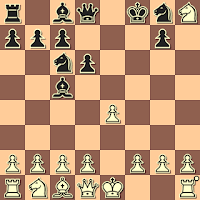
Often when I play over a Jerome Gambit (1.e4 e5 2.Nf3 Nc6 3.Bc4 Bc5 4.Bxf7+) game I check in with a computer chess engine - Stockfish, Komodo, Houdini, Fritz, Crafty... They can catch tactical errors. The newer, faster engines can even give strategic direction.
However, it can be risky turning a "refuted" opening over to a silicon beast, as there is always the chance that the assessment of any - or every - move will be "Blunder".
Discovering a game full of blunders can be discouraging.
Or educational.
Although often entertaining.
Because there can be a lot to discover in the notes.
Like in the game that follows.
SecretAccount270 - PMRF2004
5 8 blitz, lichess.org, 2021
1.e4 e5 2.Nf3 Nc6 3.Bc4 Bc5 4.Bxf7+
Blunder, says the computer again - but an interesting one.
Black's idea is purely psychological: if White wants him to accept the Bishop, then he won't. (See "Jerome Gambit Declined: ChessBrah" for one look.)
There is the possibility (the defender hopes) that all of White's opening preparation will now be worthless.
The Database has 463 games with this position, with White scoring 61%, showing that he generally copes well with this surprise.
5.Nxe5
Blunder, says the computer. Probably best is 5.Bb3, although 5.Bc4 and 5.Bd5 are also good, and even 5.Bxg8 has its merits.
I have always found the text move - showing up in 64 games in The Database, scoring 61% for White - interesting, if quirky. White continues as if Black has accepted the Bishop, knowing that if the defender does capture it later on, the game could transpose to regular Jerome lines with White a move up.
5...d6
Blunder, says the computer.
Let's see: Black attacks the Knight which protects the Bishop, and, sure, and if the Knight now retreats, 6.Nf3 then 6...Kxf7 is a bit better for Black, as Black's loss of time with his King is balanced by White's loss of time with his Knight.
But that is not the whole story. White's Knight does not have to retreat, it can exchange itself with 6.Nxc6 - attacking the Queen - and after 6...bxc6 he can withdraw his Bishop to b3. Even if Black does not recapture, but temporarily leaves two White pieces en prise, with 6...Qh4!?, White can find his way to a better position with 7.Qf3 Bg4 8.Qg3 Qxg3 9.hxg3 Kxf7 10.Na5.
The better choice for Black, instead of the text move, is the straight-forward 5...Nxe5. Let's not over-think the situation. Still, White can try 6.Bxg8, when 6...Qf6 (if 6...Rxg8 then 7.d4) is a good answer, e.g. 7.0-0 Kxg8 and White does not have 8.d4, because of 8...Bxd4 9.Qxd4 Nf3+, the trick we have seen earlier, e.g. "Jerome Gambit: Why Would He Play That?"
6.Bg6
Blunder, the computer says.
I think that is a bit harsh. This is a blitz game, and White plans a Knight fork to win the Rook at h8.
Still, 6.Nxc6 is best, is in the note above, following the previous diagram.
6...hxg6
Blunder, says the computer.
That is because 6...dxe5 is better, e.g. 7.Bf5 (7.Bh5 Qh4) Bxf5 8.exf5 Qg5.
7.Nxg6+
Blunder, says the computer.
Now White can capture the Rook with check. Instead, after 7...Ke8 8.Nxh8 there could be 8...Qh4 9.0-0 Bg4 10.Ng6 Qg5 11.d3 Qxg6 12.Qd2 with a balanced game.
8.Nxh8+ Kf8 Black resigned
Regardless of what will happen to the Knight at h8 - it will probably be exchanged off, but could just escape - White will remain the exchange and some pawns ahead.
So, a warning - if you invite a computer chess engine to help you understand your game, be ready for a whole lot of insults along the way.




No comments:
Post a Comment